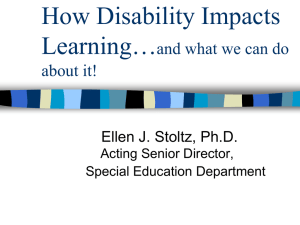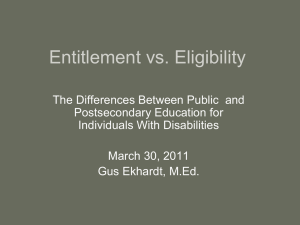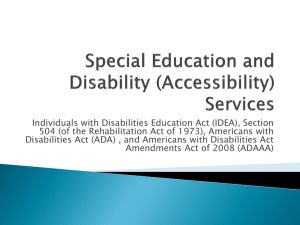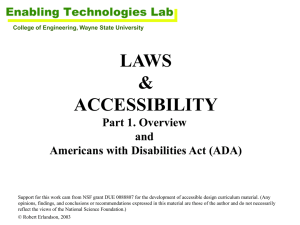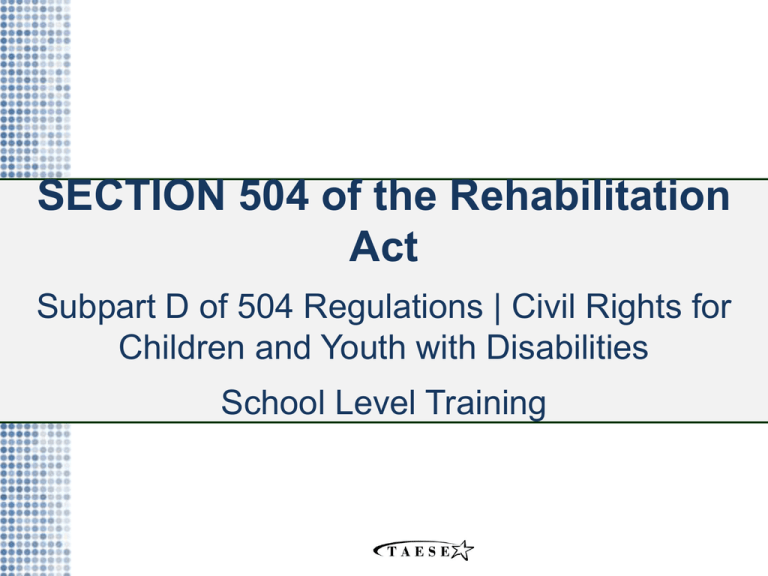
SECTION 504 of the Rehabilitation
Act
Subpart D of 504 Regulations | Civil Rights for
Children and Youth with Disabilities
School Level Training
Presenter
•
•
•
•
•
•
•
•
•
Not an attorney
Director, TAESE
Technical Assistance Provider
Special Education Teacher
LEA Director
School Psychologist
Section 504 Coordinator
General Education Teacher
Educational Surrogate Parent
Section 1
Introduction
What is Section 504 Subpart D of the Section 504 Regulations
and how does the law and regulations apply to schools?
•
•
•
•
Purpose—to provide practical guidance, information, and best practices
ADA Amendments of 2009
Not legal advice
Final word should be with the Office for Civil Rights (OCR) and your
school legal services.
Disclaimer
This presentation is not intended to provide legal advice
or establish policy, but practical implementation
strategies. The content is for general information only
and might not reflect the opinion and/or policy of the
U.S. Department of Education or Office for Civil
Rights (OCR).
The slides of this presentation should not be used out of
context or distributed to other parties. The content of
the presentation was reviewed and approved by the
regional Office for Civil Rights.
Section 2
Office for Civil Rights (OCR)
What agency provides technical assistance and enforcement
for Section 504 and other Civil Rights laws?
Office for Civil Rights
The Office for Civil Rights (OCR) in the U.S. Department
of Education is a law enforcement agency charged with
enforcing federal civil rights laws that prohibit
discrimination on the basis of race, color, national
origin, sex, disability, and age by recipients of federal
financial assistance.
• Investigates complaints
• Technical assistance
• Collects data
Section 3
Overview of Section 504
What is the purpose of Section 504 and other civil rights laws?
Critical Laws/Regulations
• Section 504 of the Rehabilitation Act
• Americans with Disabilities Act (ADA) and
Amendments of 2009
• Individuals with Disabilities Education Act (IDEA)
• State special education regulations
• Elementary/Secondary Improvement Act (1965)
• Title VI and Title IX—Race/gender
• Family Educational Rights and Privacy Act (FERPA)
• OCR/OSEP Letters
Section 504—Regulations
•
•
•
•
Subpart A — General Provisions
Subpart B — Employment Practices
Subpart C — Accessibility
Subpart D — Preschool, Elementary, and
Secondary Education
• Subpart E — Postsecondary Education
• Subpart F — Health, Welfare, and Social Services
• Subpart G— Procedures
Focus of presentation—Subpart D of 504 Regulations
* Refer to handout.
Terminology
Section 504
Americans with
Disabilities Act
Title II
Title 34 Education, Part 104
Similar Requirements
Focus of Presentation
Subpart D of 504 Regulations
• Requirements in regards to preschool,
elementary, and secondary education
• We will address student issues,
not employment.
• Follow the school policies and procedures.
ADA Amendments of 2009
The Americans with
Disabilities Act, Amendments
of 2009 created some
changes to Section 504.
* Refer to OCR Q&A.
Pupose—504
Section 504 is a civil rights law aimed at
discrimination. Like the sister statutes of Title VI
(race) and Title IX (gender), Section 504 focuses
on discrimination based on disability.
Obligations come with receipt of federal funds.
Civil Rights
• Section 504 is often referred to as the
first civil rights law for individuals
with disabilities—1975.
• Section 504 applies to students, parents,
employees, and other individuals
with disabilities.
Civil Rights
Prior to Section 504 and the Education for All
Handicapped Children Act, children were denied
a free and appropriate public education.
Types of Discrimination
Disability, aging, gender, and culture are all
part of human existence. We should accept
and respect these realities.
disABILITY
Focus on what a person can do,
not what they cannot do.
Who Must Comply?
IDEA
All public, charter, and virtual schools
Section 504
Schools that receives federal funds of any kind or
any amount. This includes private, charter, and
virtual schools.
ADA
Any business, governmental agency, or public
accommodation other than churches or private clubs.
Discrimination
Discrimination occurs when people are treated
unequally or less favorably than others
because of some real or perceived
characteristic. In schools, discrimination can
make it difficult for students to learn because
they don’t feel safe or accepted.
Discrimination
Discrimination can be…
• Real
• Perceived
• School records
* Bullying and discrimination are related.
Life is Not Fair!
• Two students, one with superior academic abilities
and one with low academic skills, cope with the same
general curriculum and expectations.
• One student has 20/20 vision while another is
legally blind.
• One student comes from a supportive family
while another deals with the problems of a
dysfunctional family.
• Individuals with disabilities have a higher
unemployment rate than those without disabilities.
Key Section 504 Concepts
Civil Rights
Substantial Limitation
Access
General Education
Level Playing Field
Accommodations
Fairness
Identification
Access to Educational Programs
• For many years, schools thought the main
responsibility under Section 504 was to make
buildings accessible (ramps, curb cuts, elevators,
larger restroom stalls, etc.)
• Within the last few years, the Office for Civil Rights
has become active in assisting schools to further
define access.
• The definition of access means more than physical
access; students may need special accommodations,
such as modified assignments and behavior plans to
benefit and access their educational program.
Section 504 of the Rehabilitation Act
General Requirements
• Prohibits discrimination against any individual
because of a disability.
• Requires physical accessibility of public buildings,
including schools.
• The school program must provide accommodations in
the general education program to allow the identified
student with disabilities to access their
educational program.
• Prohibits discrimination based upon a “record”
or “perception.”
Funding and Civil Rights
Civil Rights is a constitutional guarantee.
Congress will never provide money to States for
implementing civil rights; it’s just the right thing
to do.
“It is too bad we have to legislate civil rights.”
Martin Luther King
Section 4
Section 504
Procedural Requirements
What are some major procedural requirements
under Section 504 and how are they to
be implemented?
Some 504 Requirements
(CFR 34.104)
•
•
•
•
•
•
•
Written Assurance
504 Coordinator—15 or more employees
Public Notice
Grievance Procedure
Child Find
Written Notice
Procedural Safeguards
* Refer to 504 regulations
Section 5
Section 504 Student Identification,
Evaluation, Placement and
Accommodations/Services
What is the process and requirements for a student to
receive 504 accommodations/services?
Understand the 3 prongs relating to 504 identification.
FAPE and 504 | (CFR 34: 104.33)
Under Section 504, “free appropriate public
education” is defined as “the provision of general
or special education and related services that are
designed to meet the individual educational
needs” of a disabled student as the needs of
non-disabled students are met. A Section 504
Plan, therefore, can address such issues as health
care, behavioral, instructional, and educational
services and accommodations.
Procedural Safeguards | (CFR 34.104.36)
Once identified, the student and parent are
entitled to all of the procedural protections of the
law/regulations—notice, consent, team meetings,
manifestation determinations, due process
hearings, etc.
Identification = Procedural Safeguards Protections
Section 504
Identification Criteria
3 Prongs
Prong 1
Identification, Evaluation, & Eligibility
Prong 2
Record
Prong 3
Perception
Section 504
Identification Criteria
Prong 1
The individual has a physical or mental impairment that substantially
limits one or more of a person’s major life activities.
Walking
Breathing
Learning
Reading
Concentrating
Thinking
Communicating
Bending
Seeing
Speaking
Eating
Hearing
Lifting
Standing
Sitting
Working
Reaching
Sleeping
Performing manual tasks
Caring for one’s self
Interacting with others
Operation of a bodily function
Other ____________________
* Determined through an evaluation and a school team that includes the parents.
* Many relate to “employment.”
Impairment or Disability
There are many more people with “impairments”
than there are people with “disabilities.” The
difference lies in the effect the impairment has on
the person. If the impairment causes a “substantial
limitation” of “major life activity” then the person
has a “disability.” If the impairment does not
“substantially limit” the person, then it is an
impairment—not a disability.
How Does Section 504 Fit?
Big Picture
All students
within the school
Students
with
Impairments
504
Impairments
Substantial
Limitation
IDEA
13 Disabilities
Evaluation and 504
Although a 504 evaluation may include formal
assessment, it is not required. Only an
“evaluation” sufficient to provide information to
determine the existence of a disability under
Section 504 need be obtained. An “evaluation”
under Section 504 could consist of a meeting to
examine all existing data, including observational
data, to determine whether it is sufficient to
support a determination that the student is/is
not disabled under Section 504. (34 CFR 104.35)
Determining Identification
(34 CFR 104.35(c))
Three steps are required in interpreting evaluation data and in making
placement decisions. A school shall:
draw upon information from a variety of sources, including aptitude and
achievement tests, teacher recommendations, physical condition, social
or cultural background and adaptive behavior
establish procedures to ensure that information obtained from all such
sources is documented and carefully considered
ensure that the placement decision is made by a group of persons,
including persons knowledgeable about the child, the meaning of
evaluation data, and the placement options.
* A medical diagnosis only is not sufficient.
Three Standards for Determining
Section 504 Identification
Good evaluation data
Variety of sources
A team knowledgeable about the
student, including the parent
Individual(s) on the team
knowledgeable about the disability
Related Services
Many students under Section 504 might
only need a related service.
• School counseling
• School nurse services
• Transportation
• Other
Public Schools
Increased Numbers
Obesity
Asthma
Traumatic Brain Injury
Diabetes
Allergies
Prong Two
“Has a record of
such an
impairment”
Possible Discrimination
There are times when a student can experience
discrimination based on their school record.
Prong Three
Is regarded as having
such an impairment
— Perception—
Remember Ryan White
Contracted HIV
though a blood
transfusion.
Definition Issue
NOTE: The second and third prongs of the definition
referring to individuals with a “record of” or
regarded as “having an impairment” are relevant
only when some negative action is taken based on
the perception or record. “This cannot be the basis
which the requirement for a free appropriate public
education (FAPE) is triggered.” (OCR Policy
Memorandum, August 3, 1992).
Section 6
Section 504: Suggested
Identification Process
What are the best practices of a Section 504
identification process?
School Policy and Practices
Suggested 504 Process
1. At Risk Program
7. Review
Periodically review
and revise plan.
• Building Level
Support Teams
• Interventions and
modifications not
successful
2. Referral/Evaluation
• Complete referral
• Notice/consent
• Formal and
informal evaluations.
6. Evaluate Plan
Collect data and monitor
to determine effectiveness
of accommodations.
5. Implement Plan
Areas of accommodation
could include:
• Academic
• Health care
• Physical
• Behavioral
• Training
• Placement
3. Identification
4. Developing
Section 504 Plan
• Accommodation plan
• Possible membership
• Parent(s)
• Teacher(s)
• Principal
• School counselor
• School nurse
• Others, as needed
• Section 504 committee
• Has a mental or
physical disability that
substantially limits a
major life activity.
• Meets criteria.
• Assign case manager.
John Copenhaver, MPRRC, 1999
Section 7
Comparison of Section 504
with Special Education
What are some similarities and differences between
special education IDEA and Section 504?
Comparison
Age Range
IDEA
Section 504
ADA
Birth to
21 years*
Birth to
death
Birth to
death
* Varies by State.
Comparison
Area of Comparison
Section 504/ADA
Special Education
Type
Civil Rights
Education
Responsibility
General Education
(shared)
Special Education
(shared)
Comparison
Area of Comparison
Section 504/ADA
Special Education
Administrator
Section 504/ADA
Coordinator
Special Education
Director
Funding
School Responsibility
Local, State,
and Federal
Comparison
Area of Comparison
Section 504/ADA
Special Education
Enforcement
Office for
Civil Rights (OCR)
Office of Special
Education Programs
(OSEP)
Identification
Evaluated and currently
has physical/mental
disability that
substantially limits a
major life activity
Must qualify under
one of the 13 disability
categories
Evaluation
Required for
identification
Required for eligibility
Comparison
Area of
Comparison
Section 504/ADA
Special Education
FAPE
General education
accommodations,
special education,
and/or related
services
Must be eligible and need
special education; then
related services can be added
if they are necessary.
Service Tool
Accommodation Plan
and/or written
documentation
Individual Education Program
Team
Section 504 Team
IEP Team
Reevaluation
Periodically
Every 3 years
Comparison
Area of Comparison
Section 504/ADA
Special Education
Least Restrictive
Environment
Based upon the
Section 504 Plan and
unique needs of the
student
Based upon the IEP and
unique needs of the
student
Attention Deficit
Disorder
Is identified if the
disability substantially
limits a major life
activity
Could be served under
the categories of LD,
OHI, ED, or TBI.
Comparison
Area of Comparison
Section 504/ADA
Special Education
Grievance Procedure
Requires a grievance
procedure to deal with
discrimination issues.
Grievance procedure
not required.
Complaints can be file
with the State.
Postsecondary
Services are
provided if eligibility
is determined.
Services end at high
school graduation or age
ceiling.
Section 8
Summary and Conclusion
Questions?
Section 504 Post-Test
Story
Thank You!



